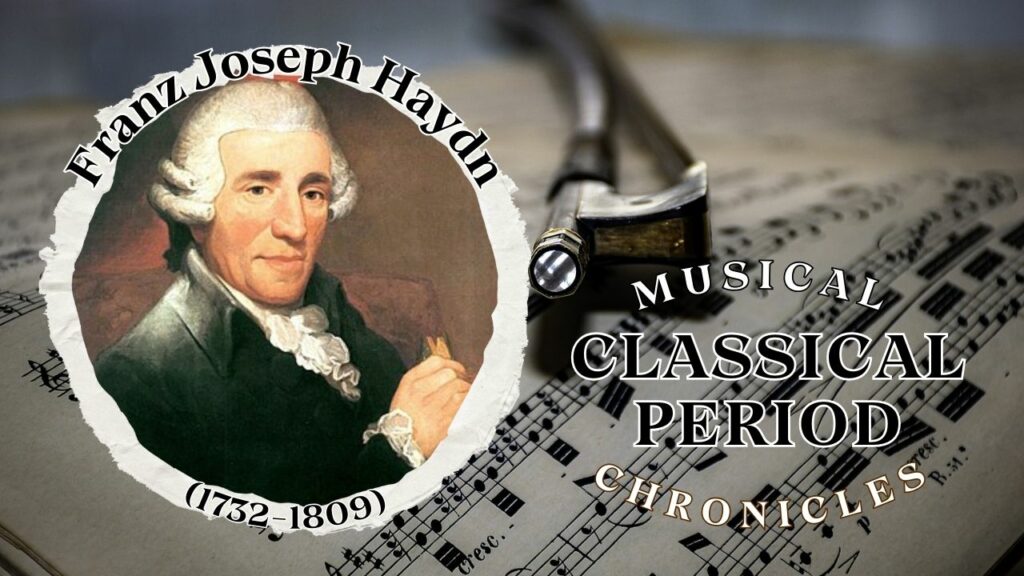
Franz Joseph Haydn (1732-1809)
Eisenstadt’s Prelude to Harmony
In the quaint town of Eisenstadt, where the whispers of history mingled with the melodies of daily life, a musical luminary prepared to embark on a journey that would echo through the annals of time. Franz Joseph Haydn, the master architect of symphonies, found himself at the threshold of a new chapter, ready to carve his name into the very fabric of musical history.
Therefore, Haydn’s episode transports us to the heart of Eisenstadt, a town steeped in culture and brimming with artistic potential. As the morning sun cast its golden glow on the cobblestone streets, anticipation filled the air. The townspeople, aware of the impending arrival of their maestro, couldn’t help but feel a sense of excitement tinged with reverence.
Eisenstadt, with its Baroque charm and regal allure, set the stage for the unfolding narrative of Haydn’s life and musical genius. In the midst of this idyllic setting, a tale of creativity, innovation, and a profound love for the art of sound was about to unravel. The town’s historical landscape, once adorned with the strokes of previous maestros, awaited the unique brushstrokes that Haydn would bring.
As the townspeople prepared to welcome their virtuoso, the very air seemed to hum with the promise of symphonic marvels. The mood captured the essence of this moment—a moment pregnant with the possibilities of Haydn’s sonic revelations, as Eisenstadt braced itself for the maestro’s profound impact on its musical destiny.
Harmony Born in the Heartland

Franz Joseph Haydn, born into a world where musical notes danced through the air like ethereal sprites, emerged as a luminary destined to shape the very fabric of classical composition. His journey commenced on a serene March day in 1732, nestled amid the picturesque hills of Rohrau, a small Austrian village that cradled the seeds of a genius yet to bloom.
From the moment young Haydn’s ears first caught the melodic whispers of folk tunes echoing through the village, he became enchanted by the enchanting symphony of life itself. His humble beginnings, marked by the rustic charm of Rohrau, laid the foundation for a legacy that would resonate across centuries.
Haydn’s early years were not adorned with the privilege of wealth or societal favor; instead, he found himself in the nurturing embrace of a musical cradle. Raised by humble parents, he discovered the magic of melody through his innate curiosity and unquenchable thirst for sonic exploration.
The budding composer’s childhood unfolded among the rustic simplicity of Austrian village life. Haydn’s ears, attuned to the harmonic cadence of nature and the rhythmic pulse of agricultural chores, absorbed the elemental music of everyday existence. In those formative years, he not only learned to appreciate the songs of the land but also discovered the latent symphony within his own being.
The melodies of his youth, drawn from the heartbeats of rural life, would later weave themselves into the intricate tapestry of his compositions. Haydn’s journey through the fertile fields and enchanting woodlands of Rohrau planted the seeds of a musical genius, nurtured by the purest essence of the art form.
As the young Haydn began to express himself through the medium of music, the echoes of his compositions resonated with the authentic notes of an artist grounded in the reality of his roots. His connection to the earth, to the very soil that cradled his dreams, infused his music with a profound sincerity—a quality that would set him apart in the illustrious annals of classical composers.
Thus, the beginning of Haydn’s musical odyssey unfolded against the backdrop of rustic landscapes and the humble abode of his upbringing. Little did the world know that the tranquil environs of Rohrau were preparing to gift the realm of classical music a maestro whose harmonies would transcend time itself.
A Harmonious Interlude
Good evening, ladies and gentlemen. We interrupt this program for an important news update from the heartland of Austria.
A musical prodigy, Franz Joseph Haydn, finds his tranquil existence disrupted by the winds of .In the serene realms of Austria, where melodic notes waltzed through the air, a captivating interruption has seized the harmonious narrative of Franz Joseph Haydn’s life. As the 18th-century sun bathed the countryside in a warm embrace, an unexpected symphony of events unfolded, creating ripples that transcended the boundaries of Haydn’s idyllic world.
The airwaves crackled with anticipation as the news anchor’s voice conveyed the unfolding drama in Haydn’s life. The idyllic village of Rohrau, known for its pastoral beauty and soulful melodies, now stood at the crossroads of destiny.
Reports from Rohrau suggest that Haydn’s compositions are catching the attention of aristocrats and patrons from far and wide. The humble son of the soil is being beckoned to the grandeur of the imperial court in Vienna, a summons that may forever alter the cadence of his existence.
The announcement echoed through the airwaves, carrying both excitement and trepidation. Rohrau, the cradle of Haydn’s artistry, faced a moment of reckoning as its musical son embarked on a journey toward the opulent echelons of Vienna. The tranquil landscape, once an unassuming backdrop to Haydn’s harmonies, now bore witness to a symphonic departure.
In this unforeseen turn of events, Haydn’s rustic melodies may soon reverberate through the hallowed halls of imperial palaces. The echoes of Rohrau, while eternally imprinted in his compositions, might find themselves entwined with the grandeur of Vienna’s cultural tapestry.
This interruption, akin to a crescendo in the narrative, left the audience suspended between the familiar notes of the countryside and the allure of the cosmopolitan stage. The interruption not only disrupted the tranquility of Rohrau but also heralded the dawn of a new movement in the life of Franz Joseph Haydn. With Vienna’s imperial court extending its invitation, the melody of his existence faced an orchestral metamorphosis.
Now, back to the show, where the unfolding composition of Haydn’s life resumes its harmonious narrative.
Haydn’s Harmonic Odyssey
Beside the verdant landscapes of Rohrau, where the whispers of nature harmonized with the melodies of life, Franz Joseph Haydn found himself at the nexus of pastoral tranquility and imperial allure. As the symphony of his existence resumed, the notes of opportunity and challenge intertwined, creating a symphonic tapestry that unfolded with each passing measure.
The radiant sun of Rohrau bathed the village in golden hues, casting a warm glow on the familiar faces that had long reveled in the cadence of Haydn’s compositions. Yet, the melodies of rustic simplicity faced a counterpoint — the resounding call from Vienna, where imperial palaces beckoned with promises of grandeur.
The rustic village square, once the stage for impromptu performances, became a tableau of both celebration and farewell. Villagers gathered, their faces painted with a spectrum of emotions, as Haydn prepared to embark on a journey that transcended the borders of his serene homeland.
The departure from Rohrau was not just a physical journey but a metaphysical one, symbolizing the evolution of an artist finding resonance beyond the echoes of his origin. As Haydn traversed the musical landscape, his compositions, once rooted in the simplicity of rural life, began to mirror the complexity of Vienna’s societal tapestry.
Vienna, with its imperial splendor and artistic opulence, welcomed Haydn into its embrace. The cultural salons and aristocratic circles became the new stages where his symphonies danced. Between the chandeliers and gilded halls, Haydn’s compositions found a grander canvas, painting musical frescoes that adorned the walls of Vienna’s cultural legacy.
Yet, the transition was not without its dissonances. The simplicity of Rohrau’s melodies collided with the complexity of Vienna’s courtly demands. Haydn, once the musical shepherd of his rustic idyll, now navigated the corridors of imperial expectations, where compositions were not just notes but reflections of societal nuances.
As the echoes of Rohrau lingered in his compositions, the imperial court became both patron and critic. The journey towards harmonic refinement unfolded, marked by a series of crescendos and diminuendos, echoing the challenges and triumphs of an artist navigating the corridors of artistic evolution.
However, Vienna was not just a destination but a crucible that forged Haydn’s legacy. The rustic harmonies may have faced a momentary interruption, but the composition of his life resumed, creating a harmonious blend where the echoes of Rohrau seamlessly merged with the imperial notes of Vienna.
This snapshot of life, akin to a musical recapitulation, allowed the audience to reacquaint themselves with the evolving cadence of Haydn’s life. As the pastoral and imperial motifs intertwined, the resumption of the symphony heralded a musical journey that extended beyond the boundaries of time.
And now, as the pastoral melodies and imperial fanfares coalesced, the audience awaited the next movement in the chronicles of musical history. The notes of Haydn’s life, forever entwined with both Rohrau’s rustic charm and Vienna’s regal allure, echoed through the corridors of time.
Haydn’s Musical Metamorphosis
As the curtain descended on the grand stage of Vienna, marking the end of one movement, Franz Joseph Haydn found himself standing at the crossroads of his own musical destiny. The symphony of his life, which had traversed the serene landscapes of Rohrau and resonated within the grandeur of Vienna’s palaces, entered a momentary pause, pregnant with anticipation for the next crescendo.
The rustic echoes of Rohrau lingered, a melodic reminiscence of the simplicity that birthed his earliest compositions. Vienna, with its imperial grandeur, had offered a canvas for orchestral opulence. Yet, as the musical score unfolded, it became evident that this was not just a departure; it was a metamorphosis — a transition from pastoral sonatas to imperial symphonies.
In the twilight of one era, the harmony found in Rohrau’s pastoral simplicity yielded to the complex orchestration demanded by Vienna’s cultural landscape. The crescendos and diminuendos of societal expectations shaped the contours of Haydn’s compositions, each note a testament to his ability to navigate the shifting tides of artistic evolution.
The departure from Vienna was not just a physical return to Rohrau; it was a return to the essence of his musical roots. The rustic village, once a stage for impromptu performances, welcomed Haydn back as a prodigal son returning to the embrace of familiar melodies. The pastoral idyll, which had inspired his earliest creations, now beckoned with the promise of a harmonious cadence.
Yet, this return was not a regression but a synthesis — a fusion of rustic charm and imperial sophistication. The symphony of Haydn’s life, marked by harmonies both humble and grand, reflected the metamorphosis of an artist who had traversed contrasting landscapes and emerged with a musical identity that resonated far beyond the confines of any one era.
As the pastoral and imperial motifs intertwined in a final harmonic embrace, the resolution of Haydn’s journey echoed in the corridors of musical history. The rustic echoes and imperial fanfares found common ground, creating a bridge to the next chapter in the symphony of musical legacies. The baton passed seamlessly, heralding the entrance of Antonio Vivaldi — a virtuoso whose compositions, like a gust of Venetian wind, promised to infuse the evolving symphony with the vivacious spirit of Baroque innovation.
Return to the Classical Period Chronicles home page.
